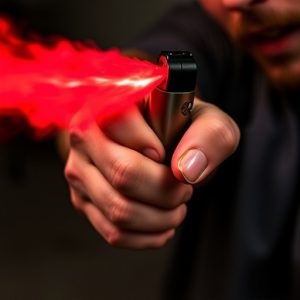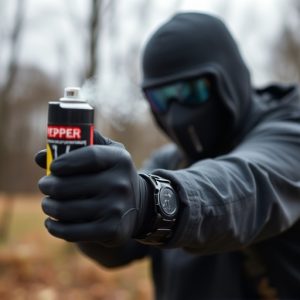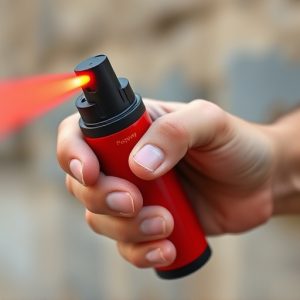Hot Climate Pepper Spray: Storage, Features, and Effective Deployment
In hot climates, proper storage of pepper spray is crucial to maintain its potency as capsaicin, the…….
In hot climates, proper storage of pepper spray is crucial to maintain its potency as capsaicin, the active ingredient, degrades quickly in heat. Law enforcement agencies should store pepper spray in cool, dry areas, avoiding direct sunlight and extreme heat sources, using specialized containers with temperature control mechanisms. "Hot climate pepper spray" tailored for these conditions offers enhanced durability and reliability. Effective management involves strategic storage, transportation in insulated bags, correct application techniques, training on physical properties, effects of heat/humidity, de-escalation strategies, and continuous education on new technology to ensure safe and effective use during critical situations like riot control or high-stress arrests.
“In the realm of law enforcement, effective tools are paramount for handling critical situations. One such device gaining prominence is pepper spray, especially designed for challenging hot climate conditions. This article explores ‘Law Enforcement Grade Pepper Spray’ in depth, delving into its composition, benefits, and unique considerations for optimal storage and deployment in scorching environments. We’ll also discuss safety protocols and training to ensure responsible management of this powerful tool.”
- Understanding Pepper Spray: Its Composition and Efficacy in Hot Climates
- Law Enforcement Grade Pepper Spray: Features and Benefits for Critical Situations
- Hot Climate Considerations: Storage and Handling of Pepper Spray
- Deployment Techniques: Optimal Use in Diverse Environmental Conditions
- Safety and Training: Ensuring Effective and Responsible Pepper Spray Management
Understanding Pepper Spray: Its Composition and Efficacy in Hot Climates
Pepper spray, a powerful non-lethal weapon, is designed to incapacitate individuals through a targeted release of capsaicin, the active ingredient responsible for the burning sensation associated with chili peppers. In hot climates, where temperatures can soar, understanding how pepper spray behaves in such conditions becomes crucial for law enforcement agencies and users alike. The composition of pepper spray is sensitive to heat; high temperatures can cause the spray’s potency to diminish over time due to chemical degradation.
Effective storage practices are essential to maintain the integrity of hot climate pepper spray. This includes keeping the spray in cool, dry places away from direct sunlight or extreme heat sources. Specialized storage containers with temperature control mechanisms can help ensure that the spray retains its effectiveness when deployed during hot weather conditions, making it a reliable tool for law enforcement operations.
Law Enforcement Grade Pepper Spray: Features and Benefits for Critical Situations
Law Enforcement Grade pepper spray is designed with specialized features catering to the unique demands of critical situations faced by officers on the field, especially in hot climates. Beyond its primary function as a non-lethal force tool, this advanced spray offers enhanced durability and reliability, ensuring it performs optimally under extreme heat conditions. This resilience is crucial for scenarios where quick deployment and sustained effectiveness are vital, such as riot control or high-stress arrests.
Moreover, modern formulations focus on minimizing environmental impact, including the challenge of hot climate pepper spray storage. Specialized containers with advanced temperature regulation mechanisms help preserve the potency of the spray while keeping it readily accessible. These features make law enforcement grade pepper spray a critical asset in the arsenal of officers, providing them with a versatile tool to manage dangerous situations effectively and efficiently.
Hot Climate Considerations: Storage and Handling of Pepper Spray
In hot climates, proper storage and handling of pepper spray are crucial considerations for law enforcement agencies. Extreme temperatures can impact the effectiveness and stability of pepper spray, making it essential to store them in cool, dry places that maintain consistent conditions. Heat can cause the active ingredients in pepper spray to degrade faster, reducing its potency over time. Therefore, law enforcement must ensure their storage facilities have air conditioning or other cooling mechanisms to preserve the quality of the spray.
Handling practices should also be adapted to minimize exposure to heat. This includes using insulated bags or containers when transporting pepper spray and storing them away from direct sunlight or heat sources. Additionally, officers should be trained on proper techniques for applying the spray, such as aiming for cooler areas like eyes and face, to maximize its effectiveness while minimizing risks associated with hot weather conditions.
Deployment Techniques: Optimal Use in Diverse Environmental Conditions
In diverse environmental conditions, effective deployment techniques for hot climate pepper spray are crucial. Law enforcement agencies must train officers to accurately assess and respond to varying weather and terrain challenges. In hotter climates, managing pepper spray in storage becomes a critical aspect of operational readiness. Proper temperature control measures, such as specialized cooling systems or secure, air-conditioned facilities, ensure the potency and effectiveness of the spray remain intact until needed.
Officers operating in diverse settings should be adept at deploying pepper spray strategically. In densely populated urban areas with high humidity, for instance, careful consideration is needed to avoid accidental spraying of bystanders. Conversely, arid regions demand techniques to mitigate the effects of wind and sunlight on spray range and accuracy. Optimal use involves understanding these environmental factors, allowing officers to make informed decisions that maximize the weapon’s effectiveness while minimizing risks in any given scenario.
Safety and Training: Ensuring Effective and Responsible Pepper Spray Management
In law enforcement, proper training and safe management of pepper spray are paramount to ensure its effectiveness and prevent accidental misuse or exposure. This is especially crucial in hot climate environments where the spray’s concentration and impact can be heightened by higher temperatures and humidity levels. Officers must be schooled not only on the physical properties of pepper spray but also on how environmental factors can affect its performance. Responsible storage practices, such as designated cool, dry areas, are essential to maintain the integrity of the spray, ensuring it remains potent when needed.
Regular training sessions should cover correct application techniques, including how to account for wind direction and personal protective equipment (PPE). Officers must also be trained in de-escalation strategies to minimize the need for pepper spray while maximizing its safe and effective use. Additionally, continuous education on new developments in pepper spray technology can equip law enforcement with the best tools for managing volatile situations in diverse weather conditions, including hot climates.
Pepper spray, especially law enforcement grade models, offers crucial tools for handling critical situations. By understanding its composition, deployment techniques, and safety considerations, particularly in hot climates where storage and handling are paramount, users can ensure effective and responsible management. These strategies empower individuals to navigate challenging environments with enhanced safety and control.


